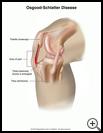
Osgood-Schlatter Disease
What is Osgood-Schlatter disease?
Osgood-Schlatter disease is a painful enlargement of the bump of the shin bone just below the knee. It is caused by inflammation of the tendon below the kneecap where it attaches to the shinbone (tibia). Osgood-Schlatter disease is most often seen in children between the ages of 10 and 15 and usually appears during a period of rapid growth.
How does it occur?
Osgood-Schlatter disease is caused by overuse of the knee in normal childhood and sporting activities. It is possible that muscles are too tight in the front of the thigh, the back of the thigh, or in the calf.
What are the symptoms?
Your child will complain of a painful bump below the kneecap. You or your child may notice a bony enlargement at the top of the shin bone. The pain will sometimes come and go and usually is gone by the time your child has stopped growing. Sometimes the pain still lasts into adulthood. The bump may remain painful and some activities, such as kneeling, may be difficult.
How is it diagnosed?
Your child's healthcare provider will examine the knee and review your child's symptoms. Your child may need an X-ray. X-rays show an enlarged tibial tuberosity. An X-ray may also show irregular or loose bony fragments from the tibial tuberosity.
How is it treated?
Your child may need to rest or do activities that do not cause knee pain. To treat this condition:
- Put an ice pack, gel pack, or package of frozen vegetables, wrapped in a cloth on the area every 3 to 4 hours, for up to 20 minutes at a time.
- Raise the knee on a pillow when your child sits or lies down.
- Use a special padded brace as directed by your child’s provider.
- Follow your provider’s instructions for exercises to help your child recover.
Your child’s provider may prescribe an anti-inflammatory medicine.
How long will the effects last?
As your child gets older and past the growth spurt, symptoms of Osgood-Schlatter disease go away. This commonly takes about 6 to 24 months from the start of the symptoms. The best way to prevent pain is to use exercise to build muscle strength and avoid overtraining.
Your child will always have a bump even after the pain has gone away. It is possible for your child to sometimes have pain in the area of the bump even after he or she is an adult. Adults with persistent pain from bony fragments around the knee need to have the fragments surgically removed.
When can my child return to his or her normal activities?
Everyone recovers from an injury at a different rate. Return to your activity depends on how soon your child's knee recovers, not by how many days or weeks it has been since the injury has occurred. In general, the longer your child has symptom. The goal of rehabilitation is to return your child to normal activities as soon as is safely possible. If your child returns too soon he or she may worsen the injury.
Your child may safely return to his or her sports or activities when, starting from the top of the list and progressing to the end, each of the following is true:
- Your child's tibial tuberosity is no longer tender.
- The injured knee can be fully straightened and bent without pain.
- The knee and leg have regained normal strength compared to the uninjured knee and leg.
- Your child is able to jog straight ahead without limping.
How can Osgood-Schlatter disease be prevented?
Osgood-Schlatter disease may be difficult to prevent. The best way to prevent pain is to use exercise to build muscle strength. Proper warm-up and stretching exercises of the thigh, hamstring, and calf muscles may also help. Your child should avoid overtraining by limiting activity as soon as he or she notices the painful bump on the top of the shin bone.
Last modified: 2011-02-08
Last reviewed: 2010-10-11

